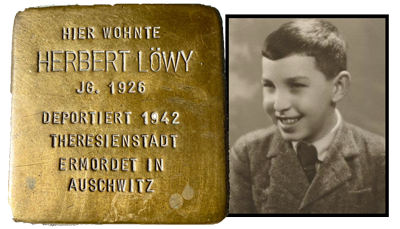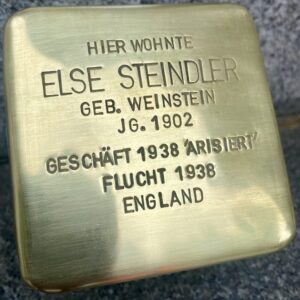The Jewish couple Rosa Weinstein née Wasserzug and Rudolf Weinstein had three children – a daughter and two sons, who were born in Salzburg:
• Else (married name STEINDLER) on February 21, 1902,
• Walter on April 25, 1903 and
• Viktor on November 13, 1905
– the Weinsteins were one of the approximately 50 Jewish families that gained local citizenship rights (»Heimatrecht«) in the city of Salzburg during the Austro-Hungarian Monarchy (1867-1918).
The Weinstein family had a shop selling haberdashery and knitwear in Salzburg’s Neustadt district, not far from the synagogue.
The name of Rudolf Weinstein, an active member of the Salzburg Jewish Community, was on the boycott list published by the Salzburg Antisemitic League [Salzburger Antisemitenbund] since the early 1920s – with the aim of destroying the means of existence of all Jews in their hometown of Salzburg.
The impact of the aggressive racial antisemitism in Salzburg is evident in the sharp decline in Jewish births and marriages in Salzburg. Unfortunately, the data must be reconstructed from other sources because the register books of the Salzburg Jewish Community, founded in 1911, were destroyed by the Nazi regime.
On March 19, 1923, Else, the eldest of the Weinstein siblings, married Eduard STEINDLER in the Salzburg synagogue. Eduard STEINDLERwas a Jewish merchant in the small town of Bürmoos, 25km north of Salzburg. On April 17, 1924, the couple had a son named Ernst. Ernst attended primary and secondary schools in Salzburg and celebrated his bar mitzvah in the synagogue on March 28, 1937 – in the presence of both of his parents, whose marriage, however, was breaking up.
Else STEINDLER set up her own business in the mid-1930s and ran a small textile shop in Salzburg’s Andrä neighborhood, in the »Faberhaus« at 2 Rainerstraße, on the left side of the main entrance. Her brother Viktor WEINSTEIN had been running a thriving general store there since April 1931, selling delicatessen, wines and liqueurs.
It is said that the fashionable »Faber Houses« on the Rainerstraße and the Franz-Josef-Straße – which were the homes of several Jewish families – were known as »Jew houses« in antisemitic Salzburg. The owner of the »Faberhaus« at 2 Rainerstraße was Geza Hartner. She rented out bars and apartments in the building and was widely believed to be Jewish, but she was not.
On March 15, 1938, the Salzburg Gestapo forcibly closed the shops of sister and brother Else STEINDLER and Viktor WEINSTEIN – with conspicuous »Jewish Shop« signs on the windows. The SS and Gestapo stole delicacies, textiles, and operating equipment. The looted »Jewish shops« were then turned over to »Aryan« tenants: Franz Suppan who sold leather goods, and Markus Maier who sold sporting goods.
Our focus, however, is not on the looters, but rather on the victims of their robbery and their expulsion from their place of residence, Salzburg.
The destination of their 60 years old parents Rosa and Rudolf Weinstein, was Tel Aviv in the then British Mandate of Palestine – where their son Walter had lived with his family since 1935 – far from his Salzburg birthplace with its rampant antisemitism.1
Walter’s sister Else STEINDLER and her son Ernst also made the leap to freedom: The two arrived in England around the turn of the year 1938/39. Thirty-six-year-old Else STEINDLER’s marriage had already ended in divorce. Her 15-year-old son, Ernst, lost his father, who failed to escape before the outbreak of World War II. On October 20, 1939, his father, Eduard STEINDLER, was deported from Vienna to Nisko in occupied Poland, where he was murdered at age 47.
Else’s brother Viktor WEINSTEIN was imprisoned by the Gestapo and held in a concentration camp for around 14 months – as a Jew suspected of being a communist:
Kommunisten unter sich [Communists among themselves]
Salzburger Chronik, 4. März 1938, p 8f.
Until his delicatessen was closed in March 1938, Viktor WEINSTEIN owned a matrix printer [called a Rexograph or Ditto machine in North America and a Banda machine or Fordigraph in the UK] that customers were allowed to use, including an activist of the banned Communist Party of Austria (KPÖ), who was alleged to have copied »The Red Flag« on the device – a suspicion that was enough to persecute Viktor WEINSTEIN for political reasons. The matrix printer had meanwhile fallen prey to the Salzburg Gestapo.
On September 5, 1938, after five and a half months of imprisonment in Salzburg, the Gestapo deported Viktor WEINSTEIN to the Dachau concentration camp. From there, he was transferred to Buchenwald: arrival on September 23, 1938, prisoner number 9966, »Jude Pol« (Jewish political prisoner). The 33-year-old Viktor WEINSTEIN was released from Buchenwald concentration camp on May 11, 1939.
His traumatic experiences as a Gestapo and concentration camp prisoner was never described in public. We do know, however, that he managed to escape to England before the outbreak of World War II. Viktor WEINSTEIN, »refugee from Nazi oppression«, married in exile in 1940, had a son, became a British subject, and died at the age of 60 in Kingston upon Thames on March 18, 1966 and was buried in the Bushey Jewish Cemetery.
His sister Else STEINDLER, who also received a British passport, died in Sunbury-on-Thames at the age of 79 on October 29, 1981 and was also buried in the Bushey Jewish Cemetery.
Her son Ernst (Ernest) gave his son, born in London on October 30, 1950, the first name Edward after his Holocaust victim grandfather Eduard STEINDLER.
Finally, it should be noted that surviving family members received no compensation from Austria for their losses, robbery, expulsion, and deportation. There is no doubt: Austrian antisemitism survived the liberation of Austria.
»… In addition to the inquiry, it is further stated that the interviewed, older, native, and local Salzburg residents cannot recall that anti-Jewish pressure—as you describe your departure—had already taken place in 1935. The requested certificate of emigration cannot therefore be issued.«
(Office of the Salzburg State Government Zl. 3.07 – 5001/57 – 1975)
Sources
- Records of the Jewish Communities in Vienna and Linz (the birth and marriage registers of the Salzburg Jewish Community were destroyed by the Nazi Regime)
- Salzburg city and state archives: Heimatmatrik, Melderegister, Gewerbeakten, Akten Landesgericht Salzburg (Verfahren 13 Vr 60/38), List of Aryanized assets (Dr. Josef Weiss, 2. 8.1945), Krieger Photograph Collection
- Albert Lichtblau: »Arisierungen«, beschlagnahmte Vermögen, Rückstellungen und Entschädigungen in Salzburg, Vienna & Munich 2004, pp. 51-53
- Arolsen Archives: Concentration camp imprisonment Viktor Weinstein
- Anno: Austrian Newspapers online
Translation: Stan Nadel
Stumbling Stone
Laid 08.10.2025 at Salzburg, Rainerstraße 2


